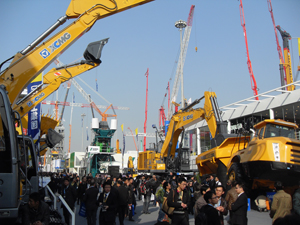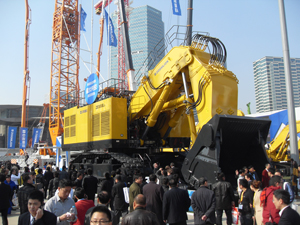

China, which is now the world's largest market for heavy equipment, is slumping domestically but its machinery exports are expected to see 20% gains over 2011. Speaking at Bauma China, a large exhibition held on Nov. 27-30 in Shanghai, officials with China's Association of the Industry of Construction Machines said they were optimistic the country's domestic market would start to recover next year.
In 2012, the Chinese equipment market faced a decline in demand, a fall in sales and an increase in exports, explained Su Zimeng, Association of the Industry of Construction Machines (CCMA) general secretary. However, on the horizon there are signs of stabilization. For example, CCMA points out that international demand for Chinese machines is still growing, but due to global economic instability, protectionism is on the rise.
"We will show the world that we are a good choice," said Su, who added that the average operating income of Chinese companies has increased by 13% this year. Last year, exports reached $15.9 billion, according to CCMA.
The equipment sector's total sales in China reached $83 billion in 2011, driven largely by infrastructure projects on the mainland. According to another trade group, the Union of the Industry of Construction Machinery of China (CNCMC), investment in just the country's hydroelectric plants is expected to reach almost $700 billion over the next 10 years. Further, China has in the works some 96 ongoing railway projects, constituting about $166 billion in investment; if the projects that have not been started were added into the total, that figure would double.
The Manufacturers
At Bauma, it was evident China's equipment makers are in a new phase of development that is focused on research-and-development investments in their machinery lines, which include tractors, shovels, diggers, pavers, cranes, cement plants and drilling machines. At the exhibition, CCMA showcased large players such as as XCMG, Zoomlion and Sany.
Walking the aisles, one could hear western and Chinese executives discussing the need for China's industry to adapt itself quickly to global emission rules and adopt sustainable production practices in order to be competitive abroad. While some pointed out the difficulty of understanding the environmental rules adopted in different countries, others said the Chinese model of doing business fails to calculate risks correctly and concentrates on sales volumes instead of profit margins.
On the flip side, Chinese companies demonstrated a strong willingness to source components from western suppliers. This strategy allows China-based firms to consolidate their manufacturing operations abroad, mainly in the emerging markets that were initially enchanted with Chinese machines' prices but now look for quality assurance and post-purchase service.
The Suppliers
Cummins has become the diesel engine of choice among many Chinese construction machines. The U.S.-based engine manufacturer has about 9,000 employees in the country, spread among 155 industrial plants that produce engines and components such as filters, combustion systems and alternators.
Despite having no plants in China, Japan-based Yanmar and Germany-based Deutz are other engine makers found amid the Chinese brands.
Germany-based ZF has a research center in Shanghai for axles, transmissions and gear assemblies as well as a partnership with China-based LiuGong to produce axles for LiuGong's construction machines.
Also performing strongly, Italy-based Carraro and U.S.-based Dana both have plants in the country that produce axles and other running gear. Other familiar supplier brands seen at the show were Germany-based radiator maker AKG, Germany-based hydraulic company Bosch Rexroth and U.S.-based engine supplier Caterpillar.
"Investments of foreign companies have increased," added Su, who noted that components also are being developed internally.

Post a comment to this article
Report Abusive Comment